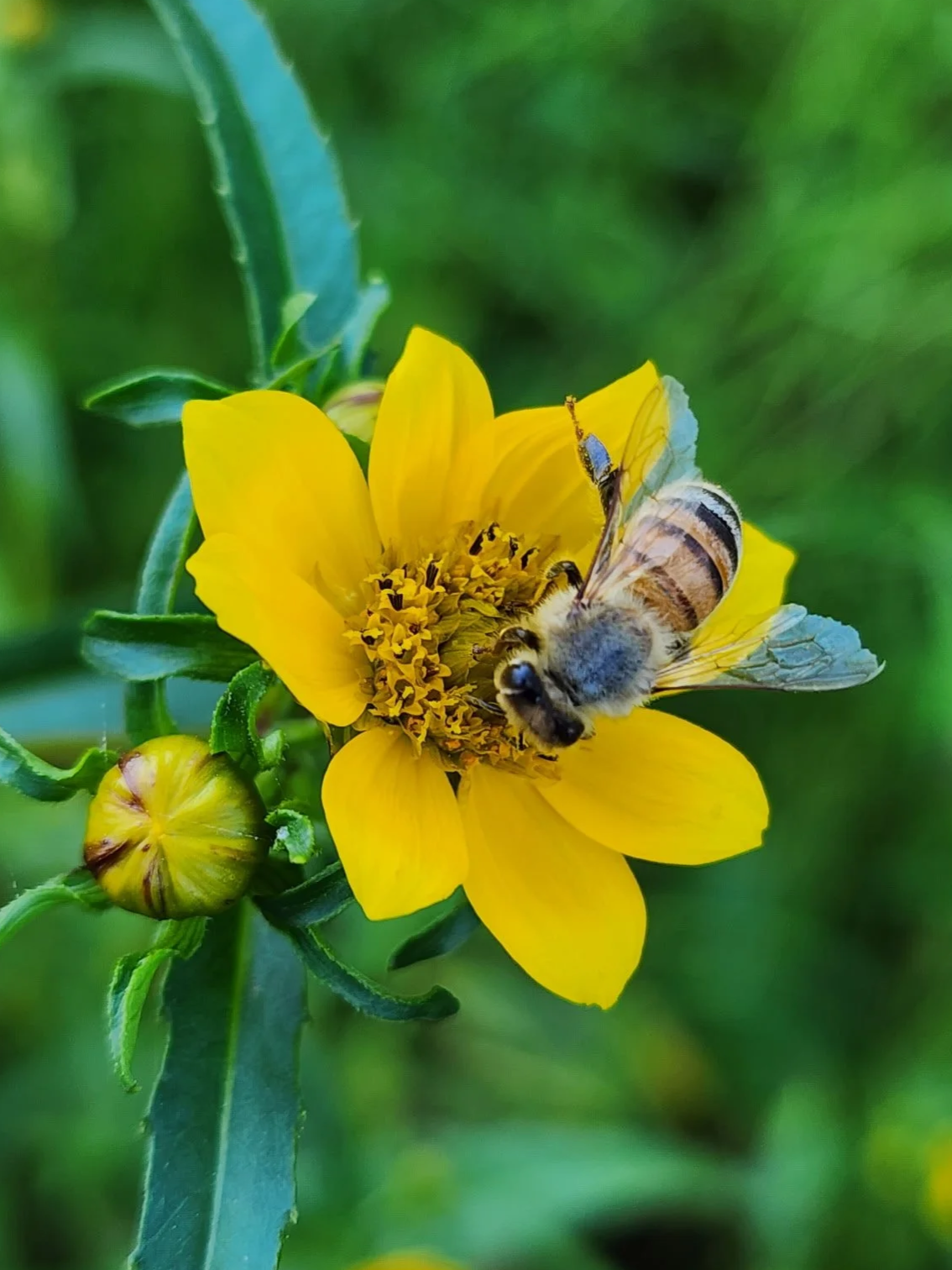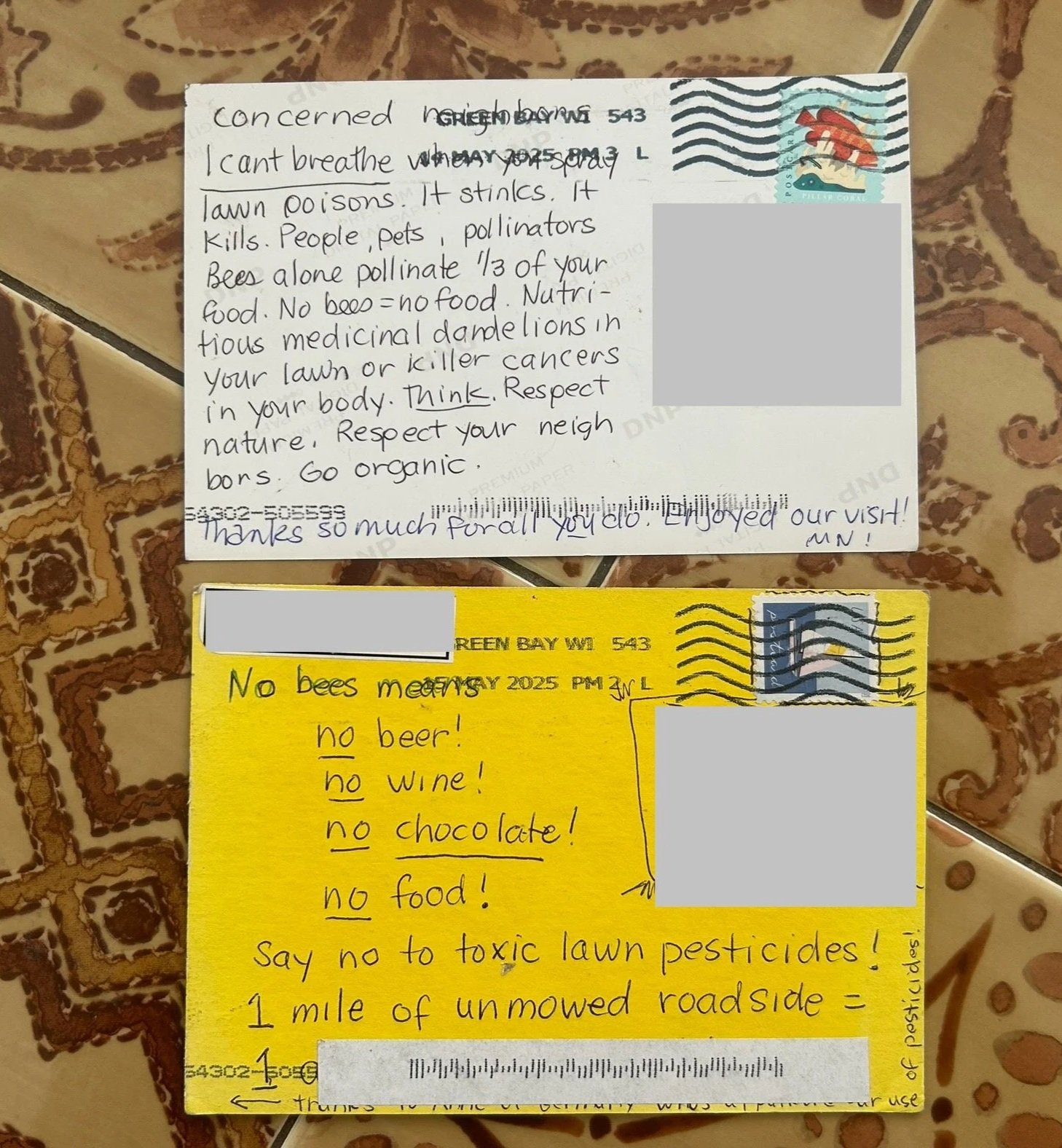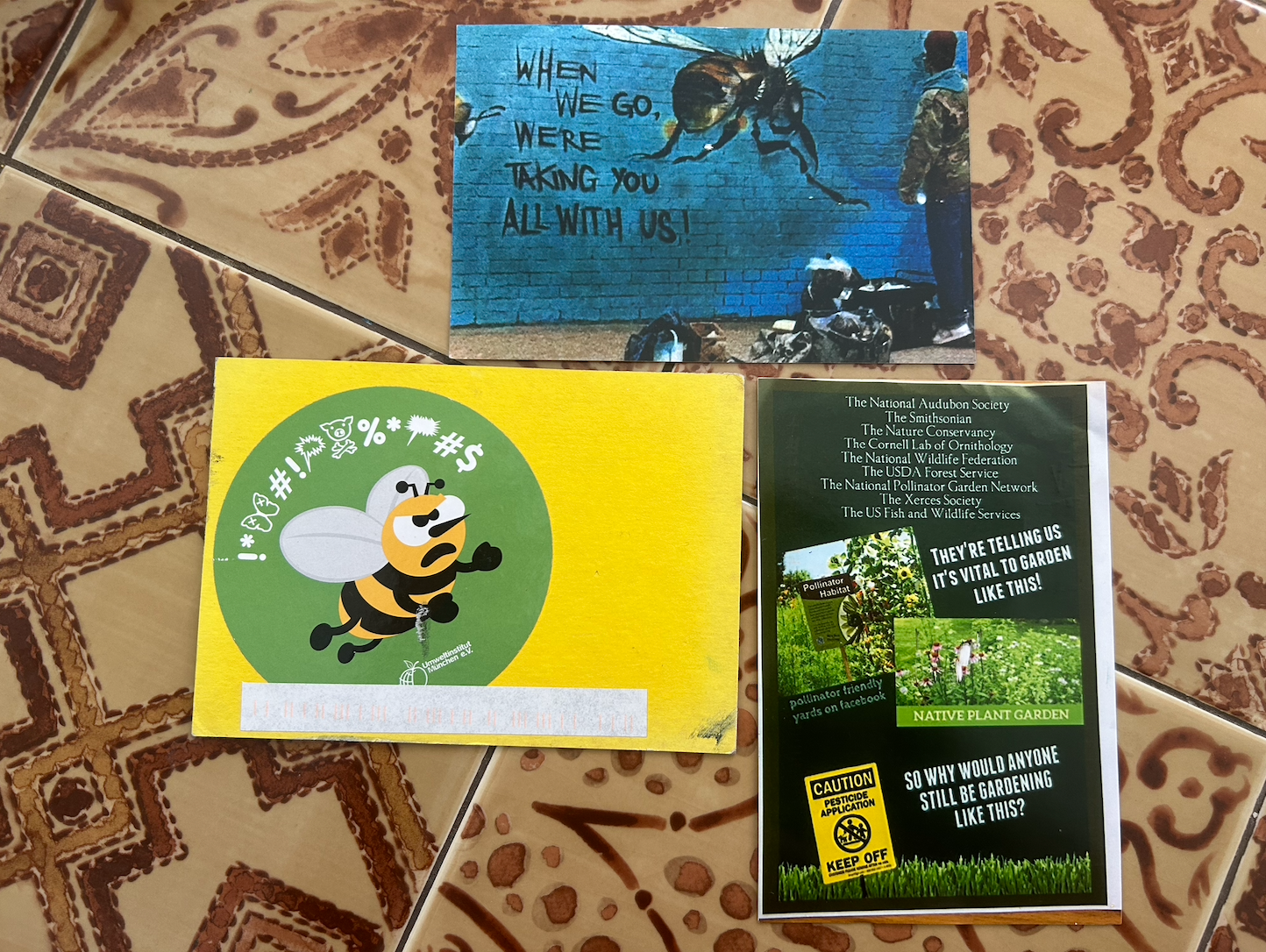Why you should grow more than grass
If you look outside your window into a sea of neatly-trimmed green blades, you may be disappointed to learn that you’re actually not necessarily looking at a healthy lawn, but maybe the opposite. Here’s why you should grow more than grass.
Pollinators are essential to our everyday lives, and yet more often than not, we overlook their existence. It’s past time we start looking out for them like they do for us, starting with our lawns. Photo by Anthony Thompson (IG: anthony.photography Tiktok: antmt0522)
Grass lawns support very little pollinator life compared to the flowering plants that attract and feed these integral insects. In fact, lawns may pose a threat to local pollinators as native vegetation is mowed away to make room for them according to the Wisconsin Department of Natural Resources (DNR). Sadly, both native and non-native pollinators are on the decline with reports saying around 60% of commercial honeybee colonies have been lost this past winter. This accounts for about two-thirds of commercially-managed honeybees in the country. While honeybees aren’t native pollinators to Wisconsin, their record-breaking death rate is still concerning as they play a huge role in the agricultural system across the United States. The United States Department of Agriculture (USDA) is investigating the potential causes for this rapid decline, but it’s safe to say that grass lawns aren’t helping.
While there isn’t one single factor which explains the widespread acceptance of the manicured American lawn we know today, it’s largely believed to have become the standard for homeowners following World War II. As homeownership steadily climbed during the post-war years, so did the number of grass lawns. The lawn became a symbol of control over one’s environment and a shared space for neighbors to convene and build community. The motorized lawn mower industry also boomed during this era, making lawn grooming accessible for the average American.
We’re not saying you should get rid of every inch of grass in your yard, but rather incorporate additional plants that will support Wisconsin’s pollinators, such as the Rusted Patch Bumble Bee,Yellow Banded Bumble Bee, Monarch Butterfly, and many more.
We reached out to Maria Otto, Green Bay Conservation Corps Coordinator, for more insight on supporting local pollinator life. Otto helps oversee the restoration of city parks and greenways with the Parks and Forestry Department.
“My biggest advice is to fill the bloom calendar. This means having a flower in bloom throughout the spring, summer, and fall. Native varieties are preferred by our native pollinators. Wild One’s Green Bay Chapter website has amazing resources and plant lists for pollinators. Some of my personal favorites are Golden Alexanders (Zizia aurea), Wild Bergamot (Monarda fistulosa), Swamp Milkweed (Asclepias incarnata), and Prairie Blazingstar (Liatris pycnostachya),” Otto said.
New England Aster is a flower that supports native pollinators and blooms in the fall. It can grow in a variety of soil types and thrives in partial to full sun. Photo by Lauren Knisbeck.
Why are pollinators so important? Of all the food crops grown around the world, an estimated 80% of them require pollination. In Wisconsin, crops like cherries, cranberries, and apples would all be significantly impacted with the loss of pollinators. Whether or not you’re a fan of these critters crawling around your yard, they are essential to maintaining the world as we know it, and keeping food on our tables. Otto explained it’s important to support local pollinators when possible as opposed to invasive/non-native pollinators because they are better suited for our particular growing region.
“Native pollinators are more efficient at pollinating our native plant species and have a longer pollinator window. They are more adapted to the cooler spring temperatures and stay active longer into the fall. Additionally, some of our native plants require special pollinating techniques such as “buzz pollination.”
The Wisconsin DNR outlines four simple steps you can take to help support native pollinators:
Plant natives
Give water and shelter
Minimize pesticides
Monitor and report your observations
Check out the Wild Ones Green Bay beginners guide to native plants here. In addition to flowering plants and grasses, edible perennials can also benefit pollinators. Some of our very own Bountiful Branches plants such as the nannyberry and juneberry can help support pollinators. Our Bountiful Branches plant sale runs every spring, so be sure to keep an eye out for sale to go live in late winter.
When it comes to herbicides, Otto says they should only be used in specific circumstances. “I think herbicide has a time and place for the overall protection of native ecosystems against invasive plant species. However, broadcast application is often detrimental to pollinators and good plant species. If the goal of application is solely aesthetics, this is often very damaging to the environment.” Otto recommends avoiding the use of herbicides when possible and favors manual removal of invasive species. She says that herbicides may be used when trying to restore habitats, but should be done at the right time, avoiding high pollination time. She recommends opting for a spot treatment of invasive plants if using herbicides instead of manual removal.
Otto and the Green Bay Conservation Corps have taken strides to support pollinator life in the City of Green Bay with the Pollinator Corridor Project. The project aims to create a chain of “stopover areas” for pollinators no more than a half mile apart. According to the City of Green Bay, in 2024, Green Bay Conservation Corps teamed up with Green Bay Botanical Garden to plant over 10,000 native plants at parks in Green Bay! The organizations plan to expand the installation sites in 2025.
The City of Green Bay also promotes “Planned Natural Landscapes” to help support native plants and pollinators, and soil and water health. According to the city, a Planned Natural Landscape consists of “a planned, intentional, and maintained area which may include, without limitation, trees, shrubs, and native plants, or vegetation associated with a rain garden.” If you live in Green Bay and want to grow plants that fall into this category – like native plants – you must register your Planned Natural Landscape with the city here.
New Leaf Foods’ own “Mother Nature”, Margaret Gerhard, has a storied history of growing plants and dealing with the city. “Back in the 80s I had a duplex in Schmidt park, [which had] kind of wild sections. These were areas where people would just leave the trees and let things grow, like the natives and I really liked that,” she said. Margaret was growing numerous plants, trees, and flowers in her yard, much to her neighbor’s dismay. Unfortunately, a complaint to the city got Margaret’s entire lawn mowed over and sprayed with pesticides.
“If anybody runs into any trouble, I learned that legally they did not have the right to do that according to the attorneys from the Wisconsin Institute of Liberty and Law.” There was, however, a silver lining to this tragedy: Margaret was able to purchase land up north after the lawsuit was settled to start her beautiful Moon Garden where she grows mostly food crops for seniors who aren’t able to do so for themselves.
Mother Nature has been a volunteer for New Leaf Foods for many years, and lends her artistic and creative abilities to our annual Brown County Seed Library Launch each year, hosting a seed art activity booth! She also donates many berry plants to New Leaf Foods, which we distribute to families in Green Bay. Photo courtesy of Kim Diaz.
Margaret has been a lifelong lover of nature, sustainability, art and recycling. “I do have my masters in art education, but the title I go by most often is ‘Mother Nature.’ Even the Department of Natural Resources calls me ‘Mother Nature’ because I do workshops for them. I’m an artist, a teacher, a student, and a dreamer, and I’m dedicated to saving the planet by artistic recycling. I recycled my lawn, and I'm proud of it.”
Back before her yard was mowed over, Margaret had curated a yard full of thriving native plants. Her inspiration to “recycle” her lawn, as she calls it, started with a realization that came from being in charge of yard upkeep while her husband was out of town for work. “I was just thinking – it was just a little patch of lawn – but it is so stupid to have this lawn mower and all this stuff; I really prefer flowers. I really like flowers,” she explained. Soon enough she had chives, mint, lilies, catnip, daisies and more, all flourishing in her yard.
Her advice to anyone who’s looking to start growing natives is simple. “Plunk in whatever you like. I’m not gonna tell people what to plant, except for pollinators and natives in particular. If you plant what you like, you’ll appreciate it even more. I do encourage people to plant herbs.” As mentioned above, natives are best-suited to our climate and environment. Margaret shared that while she was growing natives, her yard required significantly less watering than her neighbors and actually remained greener, longer. “One of my neighbors drove by and they said ‘Margaret look at your yard!’ Everybody’s lawn was really brown and parched. Mine was green, and I wasn't watering. It was because I planted natives, and the natives are resilient to drought and they can tolerate flooding.”
While it’s a common technique to turn over your soil before planting, Mother Nature has another approach. “To make it really easy, I tell people you do not have to dig up your lawn. You go to the liquor store and you buy a bottle of wine or whatever you want, doesn’t have to be alcoholic, just to be nice, and you ask them for all their empty boxes. You break down the empty boxes, then you go home and you lay all the empty boxes down. Or you get yourself a ton of newspaper and lay down an inch or two. You can do it anytime of year really but the fall is best. Lay down the cardboard, or newspaper, wherever you want the grass to be gone. You put woodchips down and then you wait until all of that gets wet, wet, wet and soggy and starts decomposing. Then, I use a serrated bread knife and just cut, I move the chips over so I can see my cardboard [or newspaper] that was disintegrating and then I cut an X in there. Then I peel the newspaper and stuff back and start plunking.”
When it comes to using herbicides or pesticides on your yard, Mother Nature takes a similar stance to Maria Otto. Margaret is part of the Helfenstein Soup Council which is a group that formed in 2012 as a peace and justice group to promote sustainable living. “I've been on the board for the SOUP council for years now, probably getting closer to a decade, and we sent notes out and canvassed neighborhoods with little posters that we put on doorknobs, telling people about the dangers of pesticides.” Margaret advises against the use of pesticides altogether. She explained one year her neighbor had an invasive species she was concerned would spread to her yard. She said that using pickle juice, or a mixture of vinegar and water, or salt and water can stop the spread of some invasives. “I would cut and bag the plant itself and pour the vinegar water, pickle juice, or saltwater on and so far I haven’t seen them come back,” Margaret said. She’s also been an active voice in our community speaking out against the use of pesticides in places like hospital lawns.
Examples of Mother Nature’s post cards to residents who use pesticides, warning them of the dangers that come with the practice. Photos by Lauren Knisbeck.
Another piece of advice Margaret has for gardeners is to get rid of 24/7 lights and solar lights. “People think solar lights are really great, and I did too when I first learned about them, but I’ve learned that they light up at night and they are killing our dragonflies, our fireflies, and our moths.” She encourages everyone to read The End of Night by Paul Bogard to learn more about how light pollution is affecting our world. “I know it’s kind of a tangent, but if you care about pollinators, you’ll get rid of your solar lights and your 24/7 lights.”
With that advice from Mother Nature and Maria Otto, we hope you’ll be on your way to growing more than just grass in your yard, and contributing to the longevity of our pollinators!
Next Steps:
Pick out some native plants
The Brown County Seed Library offers free native plant seeds! The seed library is located at the Brown County Central Library at 515 Pine Street
Consult the Wild Ones Green Bay Chapter, Wisconsin DNR, or Prairie Nursery for resources on plants and pollinators and to purchase
Visit Stone Silo Prairie Gardens in De Pere to shop native plants
Shop the next Bountiful Branches plant sale if you’d like to incorporate some delicious edible perennials into your mix
Plan and plant your pollinator garden or space
Check out this five-step guide to planting a pollinator garden
You’ll want to prep your space before planting by removing plant cover, invasive plants, and analyzing the soil type and sun availability based on the plants you’d like to plant
If you plan on digging, give Diggers Hotline a call to make sure you don’t strike anything you’re not supposed to
Turn over the soil to loosen it up before planting
3. Register your Planned Natural Landscape with the City of Green Bay
Make sure none of your plants fall under the “noxious weeds” category as defined here. This helps ensure that your garden won’t be mowed over by the city.
4. Avoid pesticides in your garden if you can
5. Report observations of insect pollinators to the Wisconsin DNR to help track trends and statuses of our pollinators
Happy planting!




